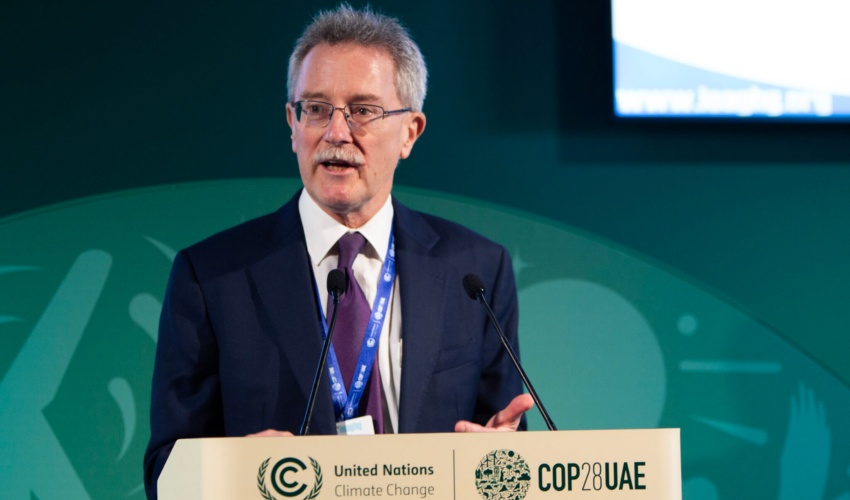CO₂ capture, utilisation, and confinement: what role in the energy transition?
In Calgary, the international GHGT-17 conference organised by the IEA focuses on the development prospects of CCUS technologies, with over a thousand experts from around the world.
Date:
28 October 2024
To separate carbon dioxide (CO2), convert it into something useful or store it indefinitely underground. A range of technologies (the so-called CCUS, from Carbon dioxide capture, utilisation and storage) born to increase the productivity of oil and natural gas fields by injecting CO2, subsequently studied as a way to reduce emissions from fossil fuel plants, and still mistakenly perceived by some as just a tool for oil and gas producers to prolong their business. But all the latest climate studies emphasise that decarbonising the electricity production sector is indispensable, but no longer sufficient. They indicate that we only have a few decades left to completely break free from the use of fossil fuels. So, one might object, do CCUS technologies lose their significance? The answer is no. On the contrary, they acquire a new, broader, deeper meaning, presenting themselves as an essential tool for the energy transition. Born to enhance the exploitation of fossil fuels, they are now, paradoxically, one of the main tools to retire them.
The development prospects of CCUS technologies were discussed in recent days in Calgary, Canada, from October 20 to 24, during the international GHGT-17 conference. Organised by the GHG (greenhouse gas) programme of the International Energy Agency (of which Sotacarbo is a member), the conference, now in its 17th edition, provided more than a thousand experts from around the world the opportunity to discuss technology development, approaches, ideas, strategic solutions, business proposals, and to establish or consolidate international partnerships.
When we talk about CCUS, we aren’t talking about a single technology, but about a broad family of dozens and dozens of approaches, technological solutions, methods, processes, more or less suitable and effective for each specific application. A broad and complex topic, with a thousand different paths leading to a single goal: decarbonisation.
To capture CO2 means to separate it from a gas mixture, such as combustion fumes (where it is typically found at a concentration between 4 and 20%) or air (with a concentration of 420 ppm, parts per million, or 400 molecules of CO2 every million air molecules). This can be achieved through liquid solvents or solid sorbents (materials that bind to CO2 and then release it, concentrated, under specific conditions), or through dedicated membrane systems. But also by burning fuels containing oxygen and obtaining, as a product, a mixture of CO2 and steam, easily separated by condensation of the latter.
The separated CO2 can be permanently confined underground, either by pumping it into depleted oil and gas fields, or by confining it in deep aquifer formations, where, due to the elevated pressure, it would dissolve in water, getting trapped.
Or, alternatively, it can be valorised, used as a reagent in different types of processes (mainly thermochemical or electrochemical) for the production of fuels and materials of various kinds.
Many approaches and many different technologies, for many different applications.
As mentioned above, work has begun to separate CO2 to pump it into nearly depleted oil and natural gas fields, in order to restore pressure and increase production. The possibility of capturing and confining the CO2 produced in thermal power plants (especially coal-fired) and natural gas plants has long been considered. Approaches that may prove useful in the coming decades, to drastically reduce the CO2 emissions into the atmosphere during the transition phase of breaking away from fossil fuels. Not a way to prolong their life, but to enable us to take corrective action.
But the interest for CCUS goes far beyond these applications. Consider the steel sector, where the use of coke is required for the process, or the cement sector, where the produced carbon dioxide can be mineralised to improve product quality. But the capture and subsequent confinement of CO2 can also be applied to power generation plants from biomass, with the consequence of an overall non-zero, but even negative, carbon cycle balance: negative emissions that bring a direct effect on reducing the CO2 concentration in the atmosphere.
And then there are countless applications where captured CO2 can be used as a source of carbon instead of conventional fossil fuels. Renewable fuels, construction materials, consumer goods. All produced by captured CO2, with benefits for both the climate (less CO2 emissions) and the environment (less emissions of pollutants).
What is the climate benefit? Think, for example, of fuels oil-derived fuels used in the transport sector: petrol, diesel, kerosene, naphtha, and many more, in which carbon has been trapped underground for hundreds of thousands of years in the form of oil being extracted, refined, burnt in engines and released into the atmosphere as CO2 (transport accounts for more than 16% of total emissions). Decarbonising a sector such as this is extremely complex and expensive. To electrify is possible for cars, less so for heavy vehicles. Green hydrogen is a good alternative for some applications, the transition would be extremely expensive (think of air and maritime transport: the entire system, from engines to logistics, would have to be revised, with huge investments).
It is precisely CCUS technologies that represent the most promising and immediate solution because, coupled with energy production from renewable sources, they make it possible to close the carbon cycle. The same fuels, in fact, can now be produced by reusing CO2, separated from the atmosphere with dedicated capture systems, and made to react with hydrogen produced by renewable sources. And when these fuels (the so-called e-fuels, precisely because they are produced from renewable electricity) are burned in engines, they do nothing more than emit the previously separated carbon dioxide back into the atmosphere. A closed carbon cycle powered by renewable electricity.
Not just that. Think of the separation and geological confinement of CO2, which initially were thought of as decarbonisation systems for fossil fuel power plants. If instead of fossil fuels the same technologies were to be applied to waste biomass fuelled plants, the balance would be negative: plants grow, taking CO2 from the atmosphere, but when they are burnt they don’t release CO2 because it gets permanently captured and confined. The so-called BECCS, bio-energy integrated with CO2 capture and confinement systems. With two results: less greenhouse gas emissions and less waste material to dispose of. A virtuous example of circular economy.
The above examples are just two of the many arrows provided by CCUS technologies to the bow of energy transition. And the sessions at the GHGT-17 conference in Calgary have highlighted many of them, underlining the great prospects for development of the technologies. Steel, cement, buildings, transport, chemical industry and many more sectors will necessarily have to resort to these technologies if climate neutrality goals are to be met.
The challenge is clear: to improve the performance of technologies to reduce the costs; to implement political and strategic choices to promote their development; to strengthen the partnerships between institutions, universities and companies to speed up their diffusion; to define constraints necessary to guarantee their security; establish international agreements and protocols to manage cross-border exchanges. And last, but not least, to involve the population, making them educated and aware in order to avoid totally unfounded alarmism. Giant steps have been taken in the past decades, but there is still a long way to go.
Fast technological development, prompted by the increasingly pressing need to reach the goal of climate neutrality, in which Sotacarbo has been playing a leading role for years.
Many are the CCUS technologies being developed at the Research Centre in Carbonia: energy valorisation of biomasses and waste to produce hydrogen and electricity by separating the carbon dioxide; capture technologies with liquid solvents and solid sorbents; CO2 conversion into synthetic fuels, also through hydrogen from renewable sources, another main research topic; monitoring systems of geological confinement sites to ensure their safety and reliability. An all-round commitment made possible by acquired skills, top-level infrastructures and a network of national and international partnerships of excellence (that events such as this help to strengthen and reinforce), which has led Sotacarbo to operate in world-class international bodies such as the SET Plan (the European Union's advisory body on energy policies), the International Energy Agency (IEA) and consortia such as CO2 Value Europe and ECCSEL, an international network of over one hundred research infrastructures of excellence in CCUS technologies. APettinau
This activity was financed by the Ministry of the Environment and Energy Security through the National Electricity System Research (Ricerca di Sistema Elettrico Nazionale, RdS) - Three-Year Implementation Plan 2022-2024 - 1.3 Integrated Hydrogen Technologies Project
Last update
09/12/2024, 17:37



